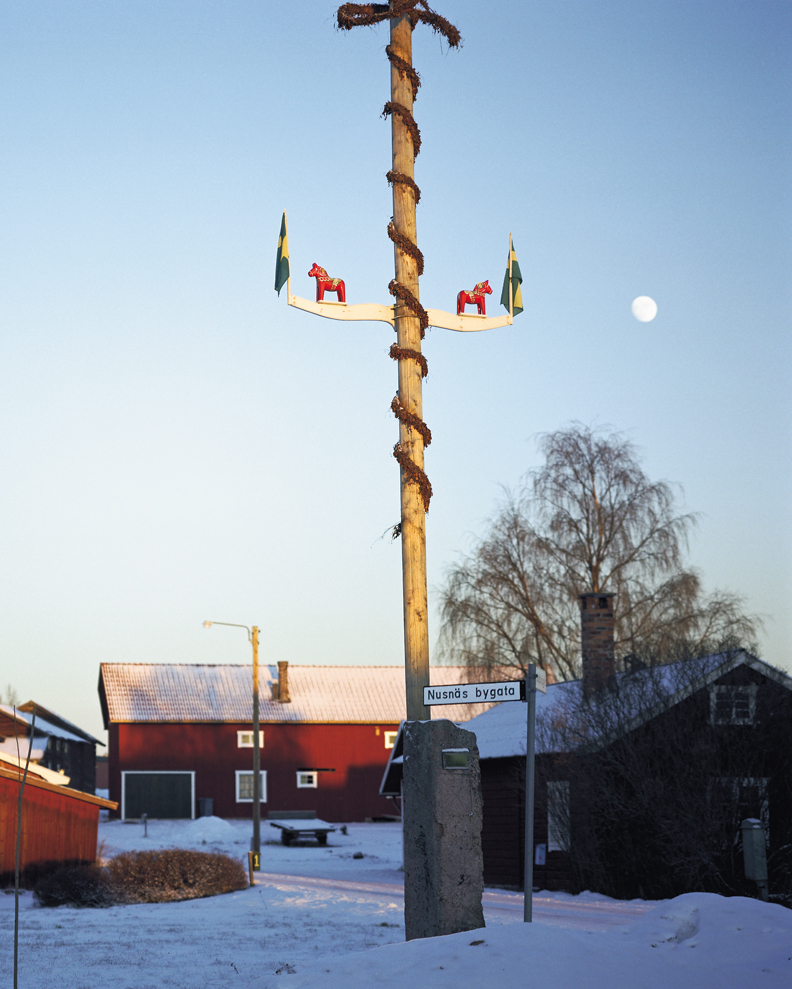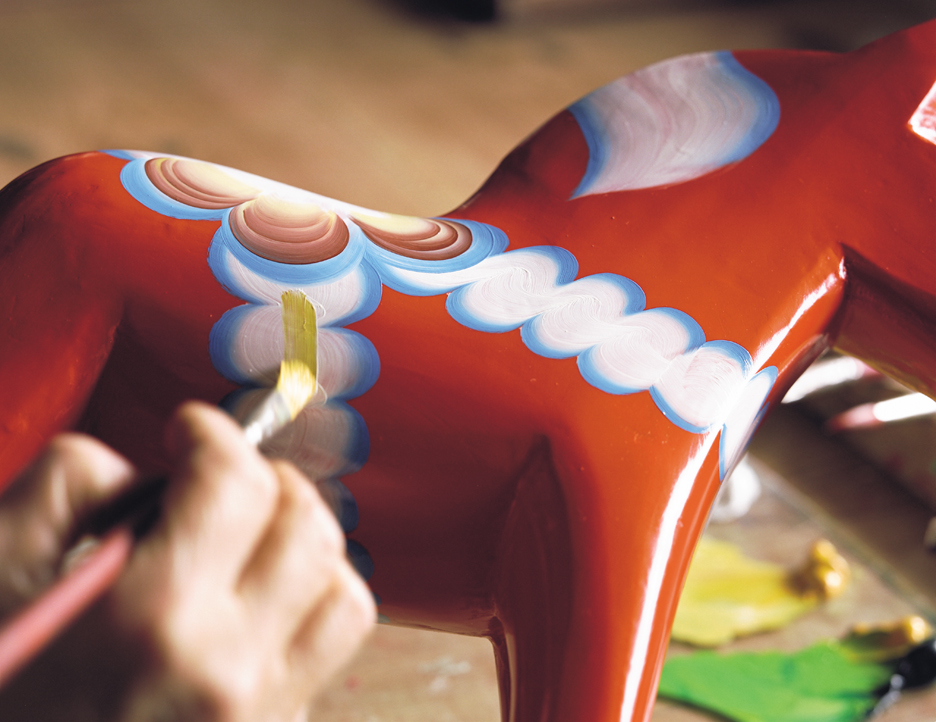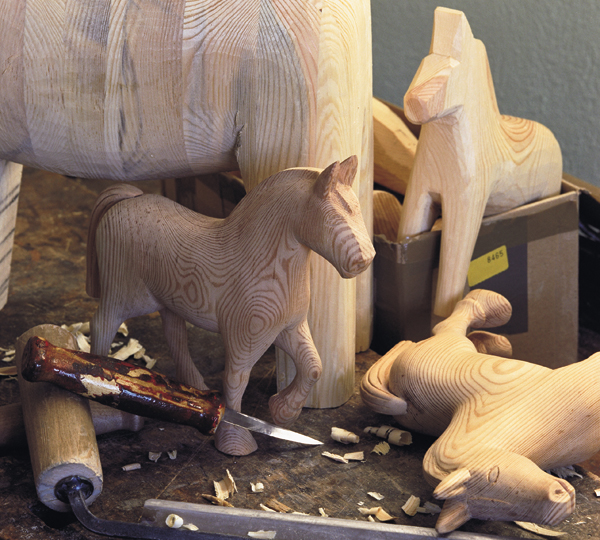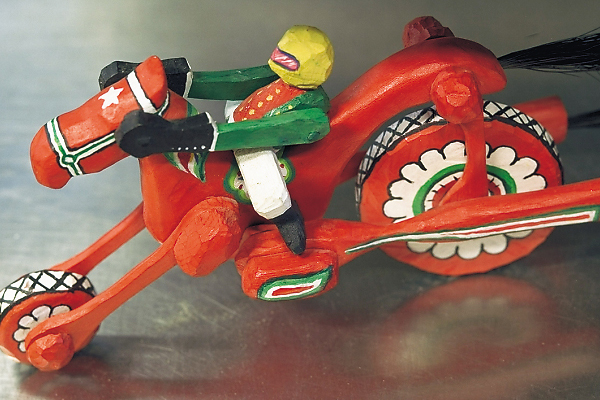A Pagan Horse Carves Its Niche
Neigh! Sweden’s Dearest Symbol Has Pagan History
-
 Even in the winter cold, the maypole in the middle of Nusnäs represents the promise of a summer that will eventually arrive. Photos by Michel Hjorth
Even in the winter cold, the maypole in the middle of Nusnäs represents the promise of a summer that will eventually arrive. Photos by Michel Hjorth -
-
The traditional Dala horse comes in every shape and size these days. Here’s a brief look at its origins through an interview with Chris Mosey, author of an earlier book on this most Swedish of national symbols.
Elvis Presley had one. So did Bob Hope and Doris Day. President Bill Clinton has one too — and his is reputed to be about four feet tall. His Dala horse, that is. -
 Birgit Johansson paints rapidly and with a steady hand in the Grannas A. Olsson workshop. She started painting Dala horses at the age of nine and estimated she had decorated around 500,000 of them — so far, in 1999.
Birgit Johansson paints rapidly and with a steady hand in the Grannas A. Olsson workshop. She started painting Dala horses at the age of nine and estimated she had decorated around 500,000 of them — so far, in 1999. -
-
Nearly everyone who goes to Sweden leaves with a Dala horse. This simple carved wooden toy, traditionally painted in red and decorated with a floral motif, is bought by tens of thousands of foreign visitors each year. It has become as great a symbol of Sweden as ABBA or Volvo, and the handicraft workshops where it is produced in the province of Dalarna have become a major tourist attraction. This year an additional amount of Dala horses have been shipped to China: The Swedish Dalahäst (Dala horse) celebrates the Year of the Horse in China
The horse’s rise to international celebrity began in 1939, when a nine-foot-tall specimen was placed outside the Swedish pavilion at the World’s Fair in New York. Americans fell in love with it.
From there, the ascent of the horse was rapid. Louis Armstrong blew his horn in the 1950s at the Stockholm Concert House in front of a huge tapestry featuring a Dala horse. In 1964, Swedish fans of Elvis Presley in the U.S. presented him with a Dala horse and a note that read, “Elvis, we want to see you in Sweden!”
Bob Hope, Doris Day, Claudia Cardinale and members of the Supreme Soviet all received horses when they visited Sweden. And when Swedish prime minister Göran Persson paid an official visit to the United States in 1996, he presented a 120-centimeter-tall replica to President Clinton.
Carl Bildt, former leader of the Swedish Conservative Party, winding up his term as head of the European Union’s peace mission to Bosnia, bought 400 small horses as farewell presents for his staff.
The little Dala horse is an international diplomat — and big business. People from around the world visit the little village of Nusnäs where most are manufactured. -
 No copyright exists on the popular Dala horse, although its use as a symbol is protected when it comes to trade and industry. In 1997, a producer of bottled water was told it couldn’t use the horse as a trademark because it had already been claimed in the food sector by crispbread manufacturer Leksandsbröd.
No copyright exists on the popular Dala horse, although its use as a symbol is protected when it comes to trade and industry. In 1997, a producer of bottled water was told it couldn’t use the horse as a trademark because it had already been claimed in the food sector by crispbread manufacturer Leksandsbröd. -
Souvenir and magical talisman
Is the Dala horse just a cute souvenir, the Swedish equivalent of London’s toy double-decker bus or the New York’s Statue of Liberty? Not according to a book written by British journalist Chris Mosey. In The Magic Horse: Devil’s Plaything that became a national symbol, Mosey uncovers the Dala horse’s link to pagan times. Evidence indicates that the horse may have been used in connection with devil worship in the 17th century, a time when scores of women from Dalarna were burned at the stake as witches. As a result, the book has caused quite a stir in Sweden, a traditionally Lutheran country for whom handicraft traditions symbolize a golden pre-industrial “age of innocence.”
“Those ‘good old days’ may not have been as innocent as modern Swedes would like them to be,” said Mosey, who worked for 11 years as a correspondent in Sweden for The Observer and The Times newspapers in London.
“Wooden horses have been found in Viking graves, and no one really knows whether they were simply toys or had some deeper religious significance,” Mosey said. “But it is accepted that in Viking mythology the stallion was sacred to Freyr, the Viking god of fertility, and that Odin, the god of war, rode an eight-legged horse called Sleipner, who could travel over the sea and through the sky.
“My theory is that when Christianity took root, wooden horses were made covertly as links back to the old pagan religion, which many people missed. As time passed, the actual links were forgotten but the horses became established in the collective unconscious as likely to bring good luck.”
As evidence, Mosey cites a sermon by Swedish Bishop Johannes Rudbeckius in 1624 that attacks goods on sale at a local market as “frivolities which serve no other purpose than conceit, sin and ungodliness — cards, dice, whistle pipes, dolls, wooden horses, love songs, foolish paintings and more of the like.” -
 They come in every shape and form. Easy Rider by Staffan Svensson. From Dalarnas Museum.
They come in every shape and form. Easy Rider by Staffan Svensson. From Dalarnas Museum. -
The truth, finally
Local critics seem to have accepted his hypothesis. “I believe the truth has finally been told concerning one of our country’s best-loved objects,” wrote Jan Broman in Falu-Kuriren, Dalarna’s leading daily newspaper, in his review of the book.
“I, for one, am quite prepared to accept that the horses may have been used as magical talismans by the witches in Dalarna. After all, in a trial in which around 70 women were accused of sorcery, it was claimed that they used small talismanic objects to cast spells and these were described by the county sheriff as small horses.”
Bo Degerman, writing in the rival paper Dala-Demokraten, stated: “It has taken a foreigner to investigate this matter for us, because we tend to be blind to our own culture. And truth be told, we’ve become more than a little fed up with all the local hype concerning the Dala horse over the years. However, Mosey has talked with wood carvers and the descendants of the master carvers of the past to dig up these new twists in the story.”
Mosey’s previous literary look at Sweden was quite different. Cruel Awakening, a study of the assassination of left-wing Swedish prime minister Olof Palme, was published in 1991 by Hurst of London and St. Martin’s, New York. Coming from that complex subject, Mosey admitted that the idea of writing 30,000 words about a little wooden toy seemed rather daunting. But once he began to dig into the story, it proved fascinating.
“You wonder at first why on earth the bishop included wooden horses in his rant,” he said. “But link this with the evidence at the witch trials just 65 years later, and it all starts to make sense.” -
By Ulf Barslund Martensson
Photography by Michel Hjorth -
Even in the winter cold, the maypole in the middle of Nusnäs
represents the promise of a summer that will eventually arrive. -
Easy Rider by Staffan Svensson. From Dalarnas Museum.
-
Birgit Johansson paints rapidly and with a steady hand in the Grannas A. Olsson workshop. She started painting Dala horses at the age of nine and estimates she has decorated around 500,000 of them — so far.
-
No copyright exists on the popular Dala horse, although its use as a symbol is protected when it comes to trade and industry. In 1997, a producer of bottled water was told it couldn’t use the horse as a trademark because it had already been claimed in the food sector by crispbread manufacturer Leksandsbröd.
-
-
